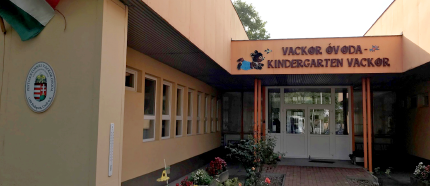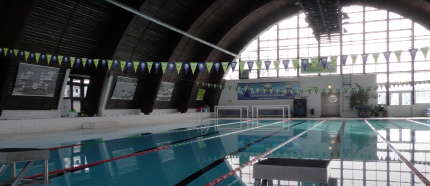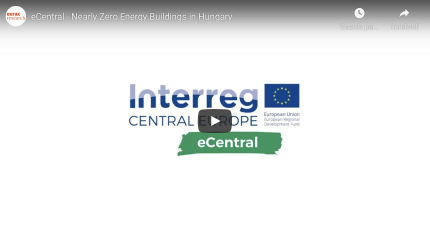PILOT ACTION 2 - HUNGARY
Renovation and enlargement of 'Vackor' kindergarten building in Budapest, BP18

'Vackor' kindergarten building
- 1. GENERAL DESCRIPTION
The Vackor kindergarten is located in the 18th District of Budapest.
The kindergarten has been built between 1978-1982 using lightweight construction DVM 12/18, PERMISOL panels as outer walls. Currently the energy performance class achieved by the building is the lower one. The goal of the renovation is to reach nZEB target following a cost effective way in accordance with the EPBD.
It is one-storeyed building with an inner courtyard surrounded by garden and with flat roofed.
- 2. ENERGY RENOVATION STRATEGIES
The Vackor kindergarten will be renovated as part of the nZEB pilot project. In accordance with the preliminary assessment the following renovation is planned to achieve the nZEB target, increasing the energy efficiency performance and indoor quality. Several renovation scenarios were analysed, and it decided to implement these renovation measures:
- insulation of the building envelope: walls and roof;
- replacement of windows with triple glazing technology, and doors;
- gas boilers replacement condensation combi gas boiler;
- use of heat pump;
- use of RES, through solar panels installation;
- monitoring and verification of thermal flows.
During the planning phase a feasibility study with cost-benefit analysis and an EPC screening report was made in order to explore the potential technical solutions to achieve nZEB. The compliance with nZEB requirements has been verified by the Energy Performance Certificates and Audit, modelled on the existing and intended conditions. It has been identified the expected energy savings and the connected investment cost and return for the chosen technical solution. The results were discussed during the Peer review workshop involving the stakeholders, what was causing some modifications compared to the original concept. The involved stakeholders were representing the municipalities, technical consultants, architect and mechanical engineers, renewable energy experts, economists, contractors and inhabitants.
- 3. FINANCIAL MODEL
The building will be renovated using carefully defined demands towards the private partner (nZEB compliance, innovation, minimum whole life cycle cost compliance, sustainability standards, public access energy demonstration centre). Green procurement criteria and state of the art of (Renewable Energy Sources (RES) technology and Rational Use of Energy (RUE) equipment, including monitoring and verification tools (smart metering) will be requested in order to bring innovation and latest technical achievements to practical use.
There are two models of ESCO financing, Shared Savings (SS) and Guaranteed Savings (GS). The difference is the investments and savings distributions between the client (currently Budapest 18th District) and the ESCO-provider.
In the shared savings model, the parties – ESCO company and municipality – distribute the savings achieved among themselves as agreed. In the case of the guaranteed savings model, ESCO guarantees to the partner (in this case the municipality) the minimum energy consumption and/or cost savings to be achieved by the investment. The guaranteed savings model is predominant, so after carefully examining possibilities it was decided to implement this model in the Vackor kindergarten pilot.
The ESCO usually assess the efficiency opportunity, purchase and install necessary equipment to improve performance. Most ESCOs will provide a financing option for these services (for instance off balance sheet financing) and maintenance as well, however it is also true that depending on ESCO the building owner may be required to seek outside financing. In “classic” ESCO financing model an ESCO charges the building owner a fee to deliver energy savings on the owner’s utility payments. Savings are often guaranteed over a set period of time. The benefits of this financing model are that the owner has a little upfront cost, generally ESCO takes on the performance risk (no saved energy no profit for the ESCO).
ESCOs historically focused on the so-called MUSH market (Municipalities, Universities, Schools and Hospitals). This last benefit has a rational reason the above mentioned buildings usually have a single, long-term owner that lowers the service company’s risk. Challenges of this financing model that it is often not good fit for small buildings as the administrative and upfront costs are high so generally we can say it is better if the project is larger so it’s worthwhile.
In this pilot we believe after we work out the solution and create a cost effective best practice, it can be transferred to other public buildings, so our project can be a pioneer.
However, there are two challenging week points. One is that ESCO financing is not common in Hungary and the other is no public building has been renovated this way yet. For reaching the nZEB status three counterfactual financing scenarios have been analysed.
Renovation and enlargement of 'Bókay Park Swimming Pool' in Budapest, BP18

'Bókay Park Swimming Pool' building
- 1. GENERAL DESCRIPTION
The Bókay Park Swimming Pool is located in the 18th District of Budapest. The building was built in the 1980s, with technology that met the requirements of that era. Currently the energy performance class achieved by the building is EE. The goal of the renovation is to reach nZEB target following a cost effective way in accordance with the EPBD.
- 2. ENERGY RENOVATION STRATEGIES
The Bókay Park Swimming Pool will be renovated as part of the nZEB pilot of eCentral project. In accordance with the preliminary assessment, the following renovation is planned to achieve the nZEB target, increasing the energy efficiency performance and indoor quality. Several renovation scenarios were analysed, and it decided to implement these renovation measures:
- insulation of the building envelope: walls and roof;
- replacement of windows with triple glazing technology, and doors;
- replacement of gas boilers with a condensation combi gas boiler;
- heat recovery ventilation;
- use of heat pump;
- use of RES, through solar panels installation.
During the planning phase it was performed several actions to explore the potential technical solutions to achieve nZEB, such as a feasibility study completed of a cost-benefit analysis and an energy performance contracting (EPC) screening report. The compliance with nZEB requirements has been verified by an Energy Performance Certificate elaborated by an energy audit modelled on the existing conditions and on planned solution sets. It has been identified the expected energy savings and the connected investment cost and return for the chosen technical solutions.
- 3. FINANCIAL MODEL
The building will be renovated using carefully defined demands towards the private partner (nZEB compliance, innovation, minimum whole life cycle cost compliance, sustainability standards, public access energy demonstration centre). Green procurement criteria and state of the art technology- Renewable Energy Sources (RES) and Rational Use of Energy (RUE) equipment- including monitoring and verification tools (smart metering) will be requested in order to bring innovation and latest technical achievements to practical use.
There are two models of ESCO financing, Shared Savings (SS) and Guaranteed Savings (GS). The difference is the investments and savings distributions between the client (currently Budapest 18th District) and the ESCO-provider.
The ESCOs usually assess the efficiency opportunity, purchase and install necessary equipment to improve the building’s energy performance. Most ESCOs will provide a financing option for these services (for instance off balance sheet financing) and maintenance as well, however it is also true that depending on ESCO the building owner may be required to seek outside financing. In “classic” ESCO financing model an ESCO charges the building owner a fee to deliver energy savings on the owner’s utility payments. Savings are often guaranteed over a set period of time. The benefits of this financing model are that the owner has a little upfront cost, generally ESCO takes on the performance risk (no saved energy no profit for the ESCO).
ESCOs historically focused on the so-called MUSH market (Municipal, Universities, Schools and Hospitals). This last benefit has a rational reason the above mentioned buildings usually have a single, long-term owner that lowers the service company’s risk. Challenges of this financing model that it is often not good fit for small buildings as the administrative and upfront costs are high so generally, we can say it is better if the project is larger so it’s worthwhile.
At the end, this pilot can be considered a best practice for nZEB target achievement, such for the high number of energy renovation strategies developed and analysed, as a pioneer of ESCO financing scheme (not so common in Hungary, where no public building has been renovated by this way yet) and contractual financing scenarios analysed.
Renovation and enlargement of 'Vilmos Endre Swimming Pool' in Budapest, BP18

'Vilmos Endre Swimming Pool' building
- 1. GENERAL DESCRIPTION
The Vilmos Endre Swimming Pool is located in the 18th District of Budapest. The building was built in the 1990, with technology that met the requirements of that era. Currently the energy performance class achieved by the building is EE. The goal of the renovation is to reach nZEB target following a cost effective way in accordance with the EPBD.
- 2. ENERGY RENOVATION STRATEGIES
The Vilmos Endre Swimming Pool will be renovated as part of the nZEB pilot of eCentral project. In accordance with the preliminary assessment the following renovation is planned to achieve the nZEB target, increasing the energy efficiency performance and indoor quality. Several renovation scenarios were analysed, and it decided to implement these renovation measures:
- insulation of the building envelope: walls and roof;
- replacement of windows with triple glazing technology, and doors;
- replacement of gas boilers with a condensation combi gas boiler;
- heat recovery ventilation;
- use of heat pump;
- use of RES, through solar panels installation.
During the planning phase a feasibility study with cost-benefit analysis and an EPC (Energy Performance Contracting) screening report was made to explore the potential technical solutions to achieve nZEB. The compliance with nZEB requirements has been verified by the Energy Performance Certificates and Audit, modelled on the existing and planned conditions. It has been identified the expected energy savings and the connected investment cost and return for the chosen technical solution.
- 3. FINANCIAL MODEL
The building will be renovated using carefully defined demands towards the private partner (nZEB compliance, innovation, minimum whole life cycle cost compliance, sustainability standards, public access energy demonstration centre). Green procurement criteria and state of the art of Renewable Energy Sources (RES) technology and Rational Use of Energy (RUE) equipment, including monitoring and verification tools (smart metering) will be requested in order to bring innovation and latest technical achievements to practical use.
There are two models of ESCO financing, Shared Savings (SS) and Guaranteed Savings (GS). The difference is the investments and savings distributions between the client (currently Budapest 18th District) and the ESCO-provider.
The ESCO usually assess the efficiency opportunity, purchase and install necessary equipment to improve performance. Most ESCOs will provide a financing option for these services (for instance off balance sheet financing) and maintenance as well, however it is also true that depending on
ESCO the building owner may be required to seek outside financing. In “classic” ESCO financing model an ESCO charges the building owner a fee to deliver energy savings on the owner’s utility payments. Savings are often guaranteed over a set period of time. The benefits of this financing model are that the owner has a little upfront cost, generally ESCO takes on the performance risk (no saved energy no profit for the ESCO),
ESCOs historically focused on the so-called MUSH market (Municipal, Universities, Schools and Hospitals). This last benefit has a rational reason the above mentioned buildings usually have a single, long-term owner that lowers the service company’s risk. Challenges of this financing model that it is often not good fit for small buildings as the administrative and upfront costs are high so generally we can say it is better if the project is larger so it’s worthwhile.
In this pilot we believe after we work out the solution and create a cost effective best practice, it can be transferred to other public buildings, so our project can be a pioneer.
At the end, this pilot can be considered a best practice for nZEB target achievement, such for the high number of energy renovation strategies developed and analysed, as a pioneer of ESCO financing scheme (not so common in Hungary, where no public building has been renovated by this way yet) and contractual financing scenarios analysed.

